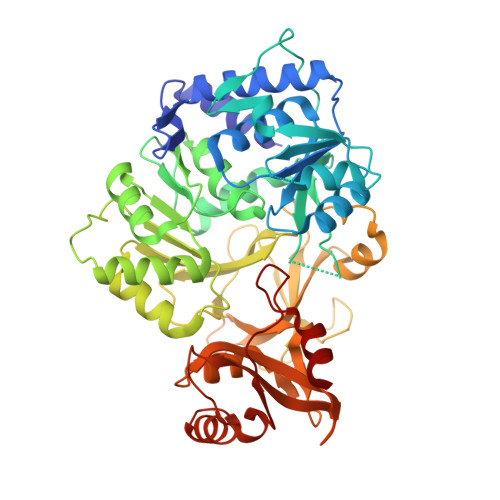Rational redesign of the 4-chlorobenzoate binding site of 4-chlorobenzoate: coenzyme a ligase for expanded substrate range.
Wu, R., Reger, A.S., Cao, J., Gulick, A.M., Dunaway-Mariano, D.(2007) Biochemistry 46: 14487-14499
- PubMed: 18027984
- DOI: https://doi.org/10.1021/bi701609w
- Primary Citation of Related Structures:
2QVX, 2QVY, 2QVZ, 2QW0 - PubMed Abstract:
Environmental aromatic acids are transformed to chemical energy in bacteria that possess the requisite secondary pathways. Some of these pathways rely on the activation of the aromatic acid by coenzyme A (CoA) thioesterification catalyzed by an aromatic acid: CoA ligase. Adaptation of such pathways to the bioremediation of man-made pollutants such as polychlorinated biphenyl (PCB) and dichlorodiphenyltrichloroethane (DDT) requires that the chlorinated benzoic acid byproduct that is formed be able to be eliminated by further degradation. To take advantage of natural benzoic acid degrading pathways requiring initial ring activation by thioesterification, the pathway aromatic acid:CoA ligase must be an effective catalyst with the chlorinated benzoic acid. This study, which focuses on the 4-chlorobenzoate:CoA ligase (CBL) of the 4-monochlorobiphenyl degrading bacterium Alcaligenes sp. strain ALP83, was carried out to determine if the 4-chlorobenzoate binding site of this enzyme can be transformed by rational design to recognize the chlorobenzoic acids formed in the course of breakdown of other environmental PCB congeners. The fundamental question addressed in this study is whether it is possible to add or subtract space from the substrate-binding pocket of this ligase (to complement the topology of the unnatural aromatic substrate) without causing disruption of the ligase catalytic machinery. Herein, we report the results of a substrate specificity analysis that, when interpreted within the context of the X-ray crystal structures, set the stage for the rational design of the ligase for thioesterification of two PCB-derived chlorobenzoic acids. The ligase was first optimized to catalyze CoA thioesterification of 3,4-dichlorobenzoic acid, a poor substrate, by truncating Ile303, a large hydrophobic residue that packs against the ring meta-C(H) group. The structural basis for the approximately 100-fold enhancement in the rate of 3,4-dichlorobenzoate thioesterification catalyzed by the I303A and I303G CBL mutants was validated by determination of the crystal structure of the 3,4-dichlorobenzoate-bound enzymes. Determinations of the structures of I303 mutant complexes of 3-chlorobenzoate, a very poor substrate, revealed nonproductive binding as a result of the inability of the substrate ring C(4)H group to fill the pocket that binds the C(4)Cl group of the native substrate. The C(4)Cl pocket of the CBL I303A mutant was then reduced in size by strategic amino acid replacement. A 54-fold improvement in catalytic efficiency was observed for the CBL F184W/I303A/V209T triple mutant. The results of this investigation are interpreted as evidence that the plasticity of the ligase catalytic scaffold is sufficient to allow expansion of substrate range by rational design. The combination of structural and kinetic analyses of the constructed mutants proved to be an effective approach to engineering the ligase for novel substrates.
Organizational Affiliation:
Department of Chemistry, University of New Mexico, Albuquerque, New Mexico 87131, USA.















